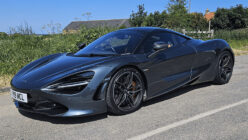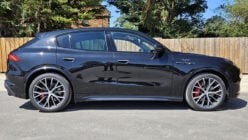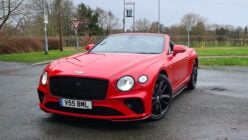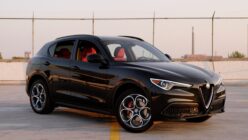In recent years, I’ve not been particularly kind to the Toyota Corolla. Three decades on from the sushi-delivering model revered by the PlayStation generation, the existing sedan had all the thrill of a marathon night of lingerie… laundry.
It was an eminently reliable car, befitting Toyota’s third-oldest nameplate. It also sold in droves, making the Corolla the best-selling car in the world. But with the rest of the compact class focusing on style and/or excitement, and the crossover trend refusing to die, Toyota’s shaken up the anchor of its car line. It’s given the Corolla a personality.
The stylish new looks were the first hint of something different. A recent #SaveTheManual event courtesy of Toyota Canada was the next. Interest thoroughly piqued, I borrowed a silver SE hatchback complete with six-speed manual for a 1300km round trip to Ottawa to see what’s changed.
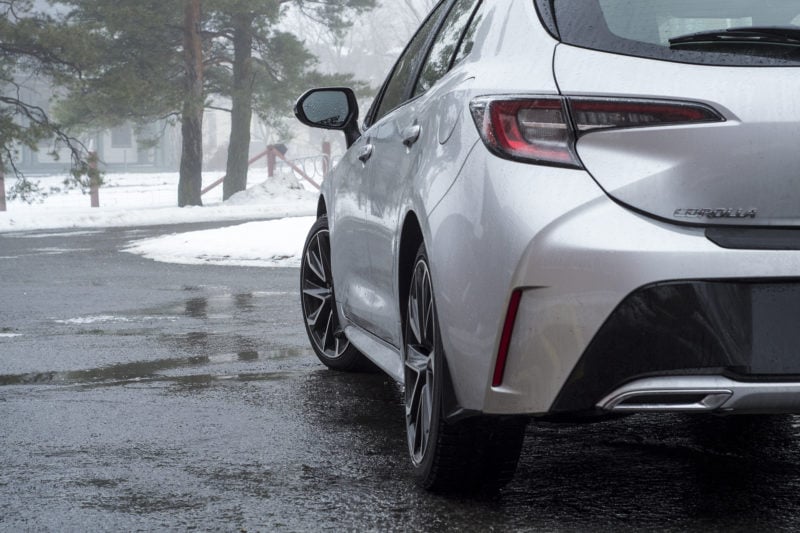
It’s quite the looker now, isn’t it?
Indeed. The existing sedan always felt a little off, the 2012 Furia concept’s basic shape stretched over the previous gen’s bones, which date back to 2006. The new model sits atop the Toyota New Global Architecture (TNGA) platform, which is longer, lower, and wider than the sedan, and the now-departed Corolla — nee Scion — iM. Weight is up too, by around 50kg for the manual.
There’s a family resemblance up front, but Toyota has dodged the same-sausage-different-lengths trend other marques have adopted this decade. There’s the requisite huge front grille, with thin headlights coming together for a blacked-out nose, complete with corporate logo. It’s aggressive and distinctive.
Arguably its best angle is the rear three-quarter, though. Wing-shaped taillights mirror what’s going on up front, lending a sense of cohesion to the design, and the spindly 18-inch rims of the SE package provide an excellent stance. The character line running along the top of the doors gives the Corolla a strong shoulder, too. It looks low and light.
Over the course of my week with the hatch, I heard “wait, that’s a Corolla?” from more than a few friends. And that’s in silver. The hero hue of the Corolla hatch, “Blue Flame”, is a bright color that really demands attention, in a good way I feel more car makers should try. Paired with an even bigger, optional rear spoiler, it also gives off some serious “drive-me” vibes. So drive it I did.

The sporty choice (but not a sports car)
First, the good news. Even on winter tires, the hatch feels miles ahead of the last Corolla. The TNGA platform is 60% stiffer than that of the iM’s, giving Toyota’s engineers a sturdier base to work with.
The Corolla rides with much more aplomb than previous models. It soaks up bumps very well, but feels sharper up front when the road gets twisty. There’s very little feedback from the electrically-assisted steering, but the helm is accurate. A fair amount of body roll signals the hatch’s handling limits early on, but as this isn’t a dedicated sports trim, it doesn’t feel unfairly soft.
The six-speed is a cinch to row through. The stick moves through the gates crisply, though the ratios feel very long. That’s no doubt due to fuel economy concerns, but the Corolla’s nat-asp engine also contributes. Putting out 168hp at 6,600rpm and 151lbft at 4,800rpm, the “Dynamic Force” 2.0-liter four makes its power the good old-fashioned way. I admire that, especially when paired with a stick, but modern buyers used to the turbo-enhanced low-down shove of other cars in the class may find the Corolla needs to be wrung out to deliver the goods.
There’s almost no effort required for the clutch. It’s incredibly light, but the long travel gives it a vague bite point. The shift assist (iMT) will automatically rev-match on downshifts, which is quite the welcome addition in an entry-level economy car. While it can’t match the speed of similar systems from Nissan and Porsche, considering the car it’s in and the target demographic, Toyota deserves praise for even including it.
iMT will also add in throttle if it senses the car’s about to stall. I tested this and it worked without fail. Even more than the rev-matching, Toyota’s onto something here. With manual car sales sitting at 4% across the industry, the company’s aiming to sell one three-pedal hatch for every nine equipped with the CVT. This sort of feature, which makes the process of learning manual less intimidating, is the key. The message at the #SaveTheManual event was that a stick-shift is just more fun, and that’s important to remember here.
The manual alone doesn’t turn the Corolla into a sports car. Though the TNGA platform will accept all-wheel drive, and Toyota does have a 2.0-liter turbo engine elsewhere in the company lineup…
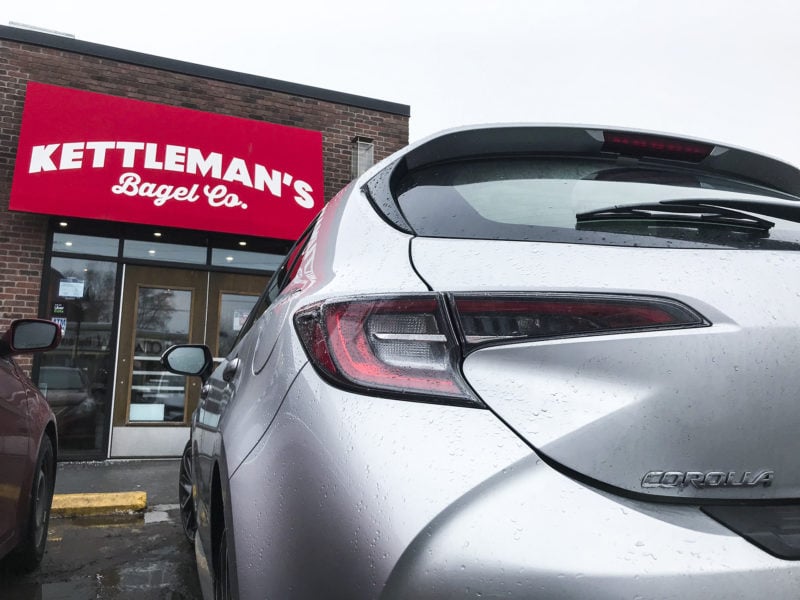
Right at home in the nation’s capital
Of course it had to snow. The night before my better half and I departed for Ottawa, the forecast called for half a foot of the white stuff. Visions of a late-autumn blast through the 1000 Islands were quickly put to bed.
Pressed into dedicated city car duty, with short bursts out of town for touristy stuff, the Corolla worked quite well. Four-up, it’s slightly squished in the back row, though people weren’t exactly brushing elbows. That stylish hatch profile does eat into storage space though, with a high, shallow trunk behind the rear seats. Naturally they can fold down if needed, but even then, the Corolla offers less space than others in the class. Luckily, all we needed to store was some light camera gear, and as many Kettleman’s bagels as we could manage.
Despite that fashionably high belt line, it’s easy to see out of. A reverse camera and blind spot warnings in the mirrors made it easy to maneuver around both Ottawa, and cyclist-happy Toronto.
It’s a good place to spend time in, the Corolla Hatchback’s interior. The dashboard plastic is soft-touch, complete with faux stitching detailing. I spent hours in the drivers seat and never once ached. There’s a fair amount of piano black trim throughout the cabin though: for those like me that are a little OCD about finger prints, consider yourself warned.
Economy cars may have more high-tech features now than luxury cars of two decades ago, but naturally they still have less than the pricier models of today. The Corolla turns that perceived negative into a positive with a pleasingly minimalist setup.
Every Corolla hatch comes with an 8-inch display in the center console, featuring Toyota’s Entune Audio suite. It connected to my phone seamlessly, letting us play our favorite tunes or podcasts on the drive. An AUX and USB connection are both standard as well, as is voice recognition and Qi wireless charging. Apple CarPlay is present, though Android users are left out.
It isn’t all touch-screen fiddling though. Toyota’s included physical buttons for the important stuff, like climate and audio controls.

What other toys does the Corolla come with?
With hundreds of kilometers of mostly highway driving between Toronto and Ottawa, I spent a lot of time getting to know the Corolla’s automated systems. Specifically, its adaptive cruise control and Lane Tracing Assist.
LTA worked as you’d expect. If the car senses you’re leaving the lane, it will gently correct the steering, usually accompanied by an audible beep. You can turn it off, and it will relax when a turn signal is active.
Adaptive cruise control turned the drive home into a bit of a high score hunt. It kept a safe distance from the car ahead — some might consider it too safe, but I know which I’d prefer — and maintained that through quite a wide range of speeds. When someone inevitably cut between the lead car and I, the Corolla would very subtly ease off to make room again instead of try to hit a set distance as quickly as possible.

With cruise control engaged, I found myself more focused on driving, not less. It became a hunt for ever better mileage, and I saw a peak of 5.7L/100km, which equates to a hair over 41mpg for US readers. By the time I was back at my condo, that had raised slightly to 6.0L/100km, but had included two stops off the highway for snacks, the scenic detour through the 1000 Islands anyway — the weather had briefly cleared — and the inescapable schlep through downtown traffic.
Other welcome upgrades in frosty Ottawa included a heated leather steering wheel and heated front seats. The latter both come with physical buttons on the center console too — no digging through menus to warm butts. Special mention to the keyless entry too: when the four of us wanted to spend as little time outside as possible, it allowed any door to be opened first, even the hatch.
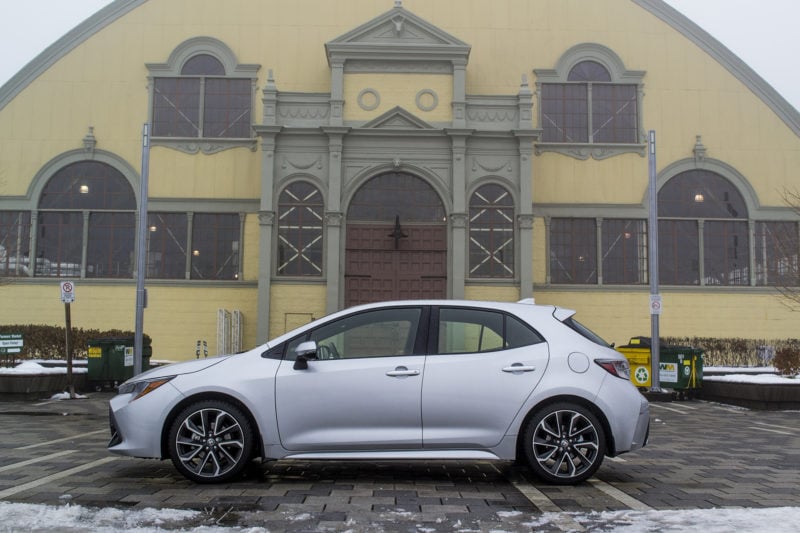
Who’ll buy a Corolla Hatchback?
It’s a hatchback version of the best-selling car of all time. So, uh, just about anyone.
First-time car buyers may well look at it, if the crossover bug hasn’t bitten them. Kidless couples, especially urban ones, will find its Goldilocks mix of pace, space, features and price a tempting one. The tight rear quarters might not make it the ideal candidate for new families: baby seats are monstrous contraptions these days.
If your particular Venn diagram also includes “easy-to-learn first manual car”, the Corolla’s iMT system really does become a major highlight.
Before the test, I had already noticed a fair number of the hatches on the road, certainly more than the unloved iM. The old Matrix was a regular on Canadian roads a decade ago: if these early days are any indication, the Corolla Hatchback could be a return to that.
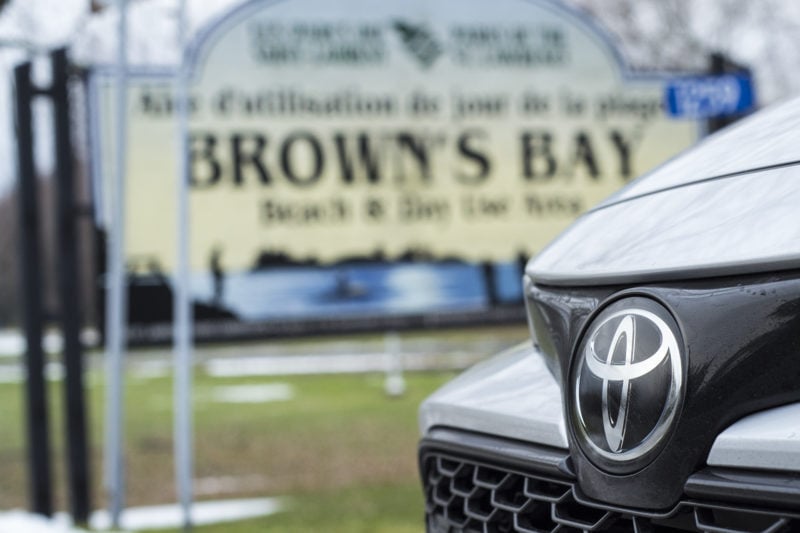
What else will tempt them?
This is a cut-throat segment. Compact cars are the big sellers in Canada, and we’re typically a more hatch-happy nation than our southern neighbors.
At $20,980 CAD, the Corolla’s starting price is very slightly higher than the others’. But it comes with the most powerful engine of them all, and more standard features.
The Mazda 3 sits at the top of the five-door food chain. With its very pretty successor coming next year, deals are bound to be had on run-out existing models. Its one-time relative, the Ford Focus, is also on the way out, meaning the same thing. It’s even cheaper, but the hatch is auto-only, unless you’re looking at the ST, which isn’t really the point here.
Korea’s Elantra/Forte siblings are also strong contenders. In terms of engines they’re practically even: all feature 2.0-liter fours with around 160hp and 150lbft. The Forte5’s only manual option is its base model, meaning a switch to two pedals if it’s to match the Corolla on features. The Elantra does offer a stick across its range, including the 1.6-liter turbo shared with the Veloster Turbo. It’s the more sporting option, though naturally that comes at a higher cost of entry.
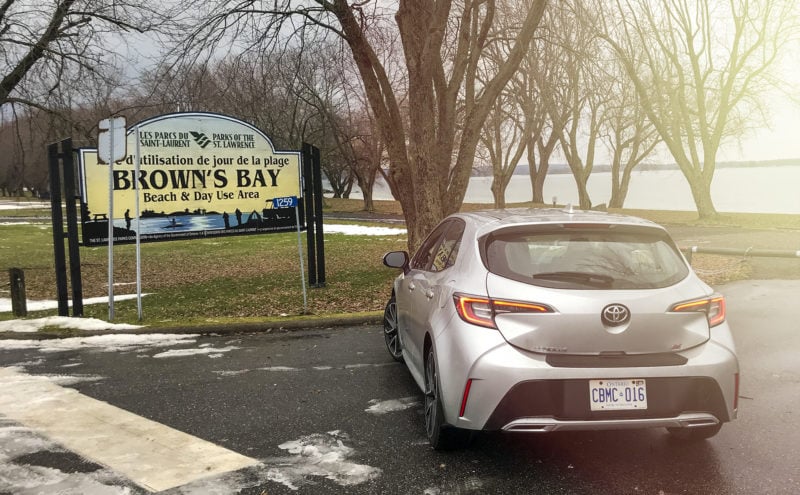
What’s the conclusion?
I genuinely liked the Corolla. It’s still happily unpretentious, but with more attitude than the milquetoast model that came before. It’s not going to fool anybody into thinking it’s a sports car, even with the manual transmission, but kudos for Toyota for putting the effort in to improve the three-pedal experience. So many manufacturers seemingly offer a manual in their economy cars for no other reason than a lower price for the marketing department. With even its old standby advantage of better fuel mileage now gone, it’s great to see a company like Toyota focusing on the sheer fun rowing your own can provide.
It’s still not the driver’s choice in the segment, but the bones are there in the TNGA platform.
Even looking past the stick, the entire package is wholly class competitive now in terms of power, features, and price. And the recent reveal of the new 2020 Corolla sedan proves the Hatchback isn’t just a one-off: the Corolla has rediscovered its mojo.
Verdict:
Toyota Corolla Hatchback
Learn more about how our rating system works.
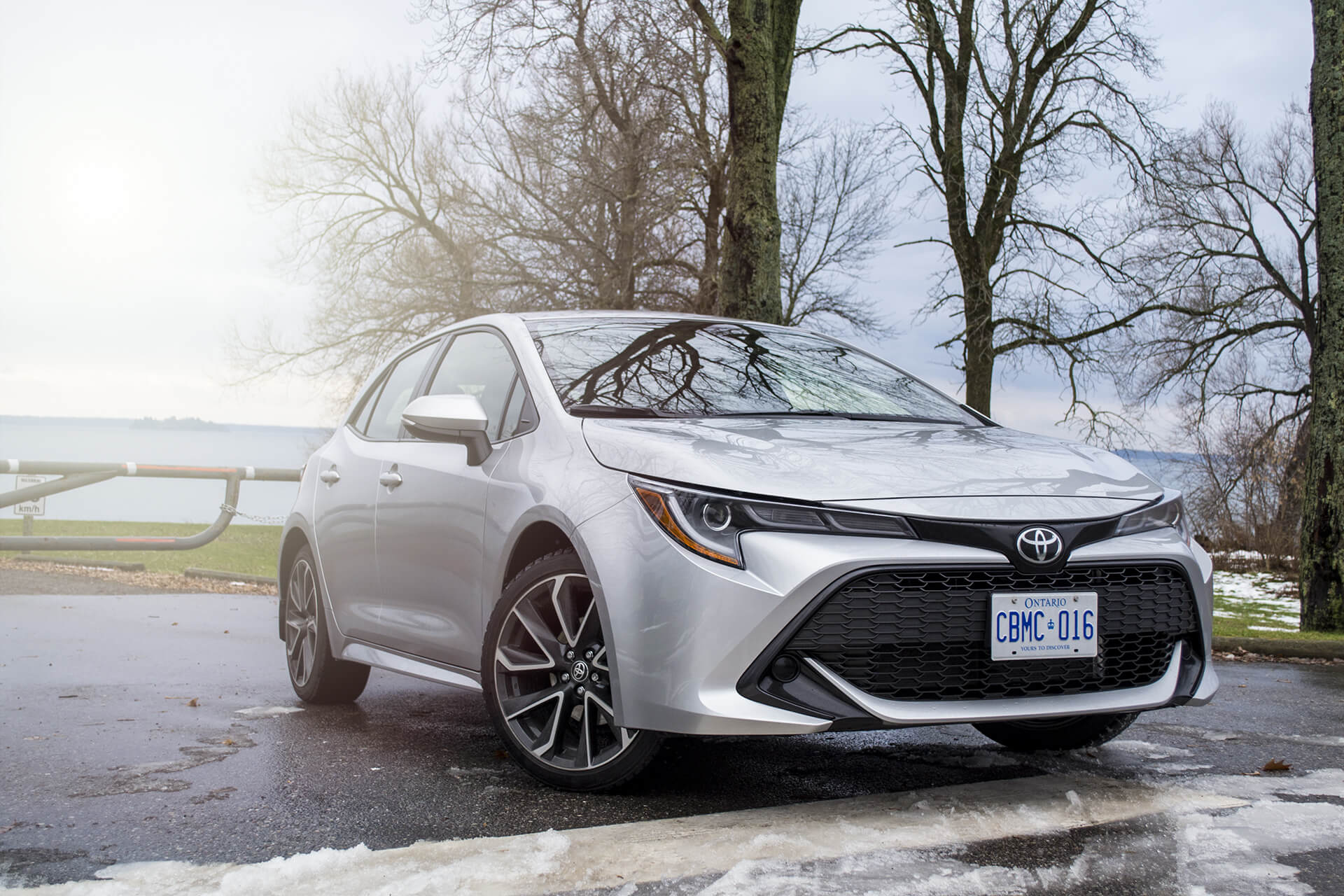
Quick Facts
See more articles on Road Test Review and Toyota.
